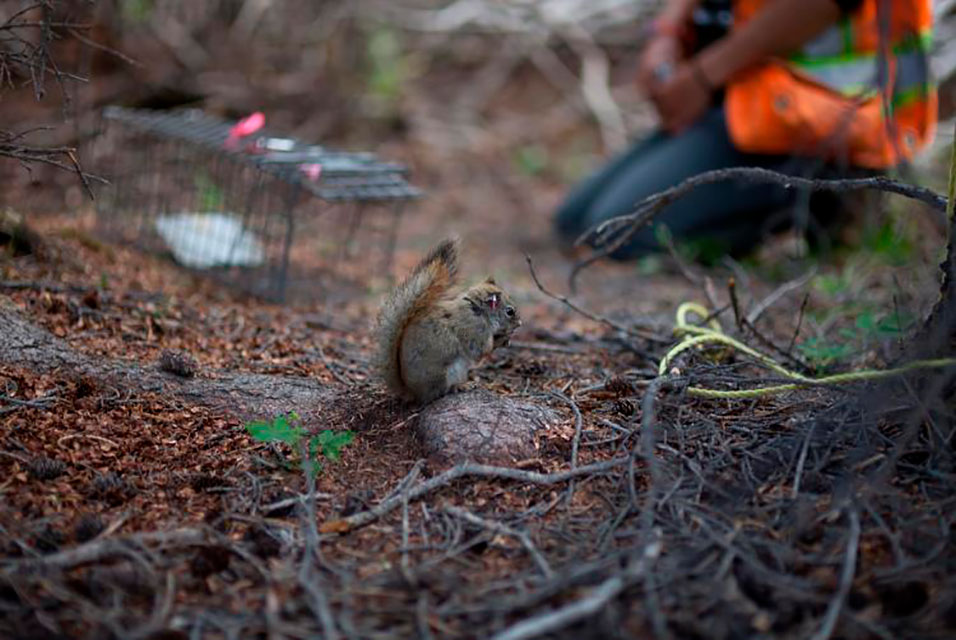BOULDER, CO.- You’ve probably seen plenty of squirrels throughout your life: in your back yard, on campus, in the park and on the way to work. New evidence suggests that the behaviors of those furry creatures could help explain the evolutionary processes of all life on Earth, including ours.
In a paper published by Science, a team of researchers including Andrew McAdam, an associate professor of ecology and evolutionary biology at the
University of Colorado Boulder, found that the red squirrels of Yukon, Canada, sometimes make mistakes when adapting to the boom-and-bust cycles of cones produced by spruce trees, their primarily food source. However, some mistakes are less severe than others and can actually help red squirrels survive in the long run.
“If what we see in nature is the result of natural selection, then organisms ought to fit with their environment pretty well. When you find these situations where there's not a good match between an organism and its environment, it suggests that either natural selection is not as important as you expected or maybe you just don’t understand the organism well enough,” McAdam says.
McAdam is a leader of the Kluane Red Squirrel Project, an interdisciplinary research group that has experimented and studied the ecology and evolution of red squirrels in Yukon for more than 30 years.
In this study, led by postdoctoral researcher Lauren Petrullo from the University of Michigan, the team of red squirrel researchers explored how those squirrels gamble with their genetic lineage to “hit the lottery” of producing a large family of pups before a mast year, when spruce trees produce an extremely high number of cones, typically every three to six years.
In most years, cones are hard to come by, which poses a challenge for female squirrels and their reproductive strategies. “But when a mast year comes along and there is a plethora of cones, red squirrel success goes through the roof,” according to McAdam.
“Squirrels typically live for around three years, so they tend to only experience one mast event in their lifetime. It is a golden opportunity, and if you aren't able to take advantage of it, you are going to lose ground relative to your neighbors,” McAdam says.
Squirrels somehow know when a mast year is coming, and they increase their spring reproduction in anticipation of the food arriving in the autumn. Researchers at the Kluane Red Squirrel Project have yet to understand exactly how red squirrels know when a mast year is coming. The current hypothesis is that female squirrels are “tipped off” by a hormonal cue when they feed on the buds of spruce trees during the spring. But sometimes they miss the memo and produce litters of pups that are either too large during non-mast years or too small in the mast year.
During non-mast years, it is difficult for litters of five to six pups to survive. “But that cost is not that big compared to the cost of missing out on the big payoffs of a mast year. You miss all that potential recruitment of pups that you could have had by not producing the big litter in the mast year,” McAdam says.
“When we stepped back and considered those mistakes within the bigger picture, we realized that this mismatch is part of a larger strategy that is beneficial for the squirrels. They're willing to tolerate these smaller mistakes because it helps them to avoid making the costlier mistake” of missing out on the mast year, according to McAdam.
For McAdam and the rest of the red squirrel team, their decades-long study of squirrels is about more than just the squirrels. Yukon red squirrels and their risky decisions on when to produce large or small litters are a window into how all organisms respond and adapt to their changing environment.
“Squirrels are like a microscope; they're efficient at revealing biological patterns that we wouldn't be able to see” from other animals, McAdam says. “They're really a way to understand the basic workings of biology.”
Humans also have to make decisions based on limited information. Like red squirrels, “We're constantly faced with lots of choices that have different levels of risk, and we have to find a way to navigate the world, trying not to make big mistakes—even if that means you make a few small mistakes along the way,” McAdam says.
Within the world’s shared biosphere that is constantly changing because of human-caused global warming and other disruptions, McAdam’s co-authored study is a reminder to “not sweat the small stuff and to instead stay focused on the things that really matter in life.”
“We tend to think that our human stories are the most important stories. But even familiar critters have interesting lessons to teach us,” McAdam says.
The research is co-authored by Lauren Petrullo and Ben Dantzer from University of Michigan; Stan Boutin from University of Alberta; and Jeff Lane from University of Saskatchewan.
The study was funded by the Natural Sciences and Engineering Research Council, the National Science Foundation, Polar Knowledge Canada and the Canadian Foundation for Innovation. This research took place within the traditional territories of the Champagne and Aishihik First Nations.










